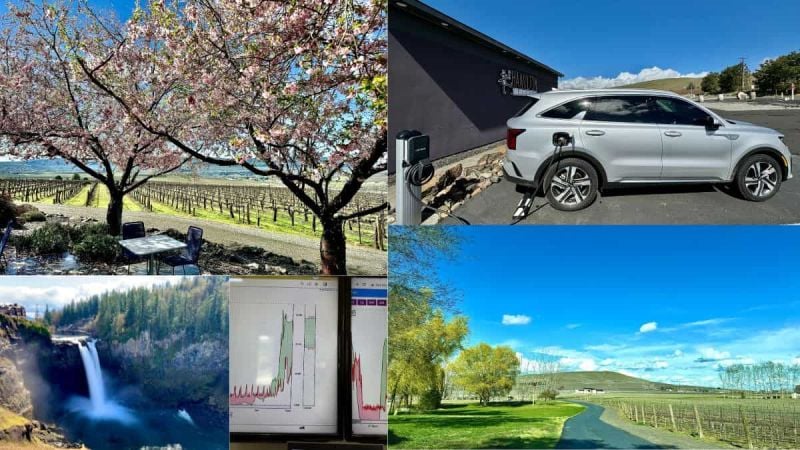On previous trips, I either manually switched between the electric (EV) and hybrid (HEV) modes of my Kia Sorento PHEV, or I drove it in Sport mode. I did the two previous drives in April and in May, and this past weekend I did it in March, though temperatures were similar (within about 10 degrees) for all 3 trips, there were a few critical details about this weekend's trip I need to share up front:
- I had my softer, knobbier (i.e. higher rolling resistance) snow tires on.
- I did not have my roof rack on.
- On the way over it was raining hard enough for there to be standing water on the road.
- I had about 1,000 lbs of people and cargo.
- I drove slightly faster this time (averaging about 3 MPH faster than prior trips).
I did the same first 6 or so miles of the trip in EV mode, as I did previously, in order to leave plenty of space for recapturing charge from coasting or braking. When I made my prior trips I was able to get around 37 MPG each time. This time, I used Smart mode on the outbound leg and Sport mode coming back (as on other trips, switching manually into EV mode to use up the stored energy that accumulated from using Sport mode and arrived with 0 miles of EV range). I got much worse gas mileage, on both legs: 32.5 MPG on the outbound trip and 29.8 MPG on the return.
Note, on the return I started with the hybrid battery at only 55% state of charge, instead of 100% as I did on the other trips (after getting a free charge for about 6 kWh, all generated via solar panels, at a winery on Red Mountain in Benton City, WA).
But anyway I slice it, this is literally the worst fuel efficiency I have ever gotten on a long road trip in my Kia Sorento PHEV. We can with certainty conclude the following as reasons for the worse fuel efficiency results: my speed, my tires, the rain, and the extra weight all contributed to worse figures (the lack of roof racks likely helped a tiny bit though). Physics always wins my friends, and the greater resistance from the tires, the rain and the air (from driving a little faster) all detracted from my fuel efficiency. The weight we were hauling was probably only a minor factor, mainly on the uphill stretches over the passes; the small 1.6L turbo 4 cylinder engine in the Sorento is remarkably efficient, but it has to work hard under such strenuous conditions.
I observed that Smart mode will keep using the battery charge while driving, whenever the algorithm determines it is beneficial, unlike just switching the Sorento in HEV mode via the toggle switch between the seats, which just sustains the battery state of charge (and will slowly replenish any bits of charge it may use when greater power is needed). That may be fine, but I would suggest that it is possible the algorithm isn’t using the battery as wisely as I would have and thus isn’t particularly “smart”.
As I have said before, we are smarter than our cars! I am making this trip again in early May with a similar payload, but I will have swapped out my snow tires for my all seasons then and the temperatures should be slightly warmer. I will make that drive manually switching between HEV and EV modes on one leg for comparison, and will drive at a similar speed otherwise.
On the trip back, I experienced something sort of like range anxiety for the first time in my PHEV (really, it was more like range ennui). When I filled up my tank before heading back home, my Sorento said I had 407 miles of range from a full tank plus the remaining charge on the battery. I drove 207 miles, and should have had 200 miles of range left (if the Kia’s algorithm was accurate). Yet I made it home with only 157 miles of range on the dashboard display (having used up all my battery range too).
I drove the speed limit pretty much the entire way, in Sport mode, except when I sped up a few MPH to pass a slower vehicle or occasionally 3-5 MPH under the speed limit for a short stretch and for about 30 miles when I was in EV mode. I also switched to Smart mode for a mile to check the engine RPM vs Sport mode and as I have seen multiple times before, the engine drops about 700 RPM when switching between Sport and Smart mode at 70 MPH (and kicks back up the same amount when I switch back to Sport mode). This shows once again that Sport mode could only end up being about as efficient as other modes, at best, when on long, flat or slightly downhill drives (like heading toward the Mississippi River from the Rockies) where the gas engine would not need to rev much more in order to provide some charge back to the battery.
People suggesting otherwise may be being misled, in fact, by the algorithms displaying range and or MPG figures, which for example can seem “artificially” high when a larger percent of miles are covered on electric power (whether or not the electricity came from the grid or from the gas engine).
Anyway, my ennui was of my own making and I know that, and I certainly don’t blame Kia. At no point did I feel like I was going to run out of gas before I made it home, but obviously Kia’s algorithm doesn’t know and can’t factor in things like elevation changes, headwinds, cargo weight, rolling resistance, etc. in its calculations. I mention this because of all those who complain or call out the issue with fully electric cars (especially Teslas) and their range estimates.
My Kia PHEV was off by at least 27% (likely more had I driven until almost empty on the highway). I’m not trying to emphasize that some automakers are doing a bad job with their range estimation algorithms (though some are), rather we should all take into consideration the fact that range is always just an estimate based on very incomplete data and while in some conditions they may be very accurate, they are usually off by a little, if not a lot and we just need to accept that.
And that leaves me with an obvious conclusion: in order to maximize the efficiency of my Sorento PHEV, or pretty much any vehicle for that matter, slow down (even just a few MPH). Also, be conscious of the other primary contributing factors affecting your vehicle's efficiency like rolling resistance (from tires) and wind resistance (from headwinds or aerodynamics), and either make adjustments or accept the outcomes.
Are you a fan of PHEVs? Are you ever let down by your range or efficiency results? Did you have expectations when you bought it that have gone unmet? If so, please share your experiences, questions or comments below.
Images courtesy of Justin Hart.
Justin Hart has owned and driven electric vehicles for over 15 years, including a first generation Nissan LEAF, second generation Chevy Volt, Tesla Model 3, an electric bicycle and most recently a Kia Sorento PHEV. He is also an avid SUP rider, poet, photographer and wine lover. He enjoys taking long EV and PHEV road trips to beautiful and serene places with the people he loves. Follow Justin on Torque News Kia or X for regular electric and hybrid news coverage.











